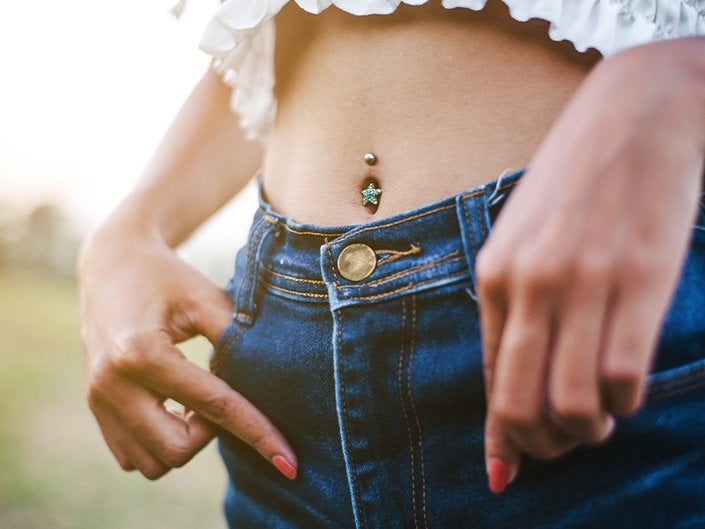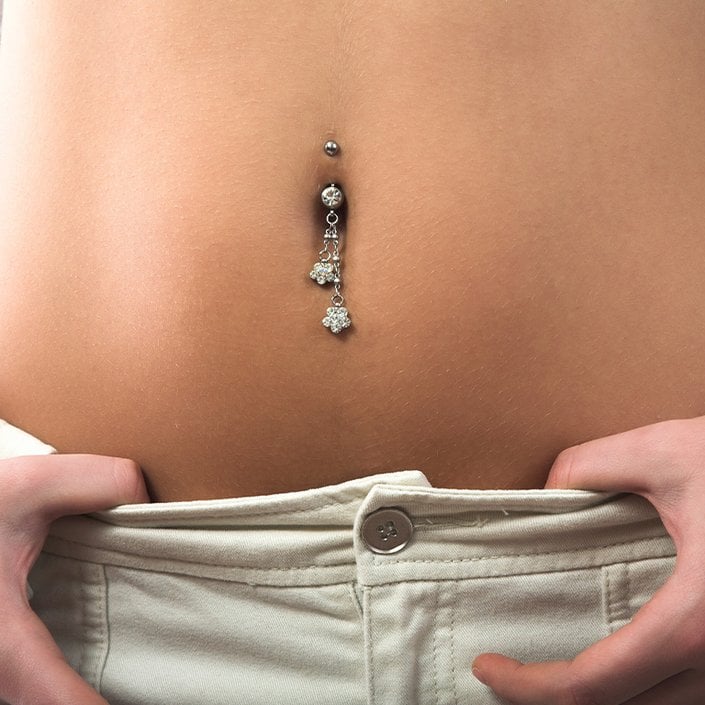The Ultimate Guide to Belly Button Piercings
June 29, 2023
What Is a Belly Button Piercing?
A belly button piercing is a piercing of the skin similar to piercings of other parts of your body, like your ears or your nose. It’s a piercing of your navel, which is why it can also be referred to as a navel piercing. This piercing will likely be placed slightly above your belly button so the jewelry can complement the belly button (rather than the jewelry hanging below it).
Does a Belly Button Piercing Hurt?
“It’s really not that painful,” says Thompson. “Sometimes, if it’s pierced improperly, like it’s a little too deep and the jewelry is not long enough or not the right size, it can cause problems. Or if you’re sensitive to nickel and have the wrong type of jewelry.” In other words, it’s important to do your research and be thoughtful about choosing the right piercer and jewelry for you. “These are all things that can be fixed, though,” he says. “So even if you’re having an adverse reaction, before it gets too out of control, go talk to your piercer.”
Piercings are never completely permanent: They can be removed, and there’s almost always a way to fix it, Thompson shares. “The great thing about piercings is that you can take them out and start over again,” he notes. If you’re concerned or have questions about the state of your piercing, consult with your doctor.

How to Clean a Belly Button Piercing
Cleaning your belly piercing is your best bet against infection and irritation. Here’s the ultimate secret: be gentle. The first day, you aren’t going to do much with it — it’s best to leave the piercing alone, Thompson advises. After that, aftercare and cleaning it will be the key to success.
Step 1: Gently Massage the Piercing With Soap
For cleaning the piercing, Thompson recommends applying a fragrance-free soap daily. “Gently massage the soap, and I can’t stress that enough: gently,” says Thompson. “You don’t need to aggressively get in there underneath it and really work the soap. All you’re doing is gently rubbing, gliding the lather around the entry and exit of the navel [piercing] around the jewelry.”
Step 2: Thoroughly Rinse the Area and Pat Dry
He notes that rinsing the area is extra important to avoid skin drying out. After, pat dry the area; don’t rub.
Step 3: Follow It Up With Saline Aftercare Solution
Both Thompson and Dr. Mian recommend using a saline solution during the healing process of your belly button piercing.
“Incorporate a saline solution, and NeilMed makes a great piercing aftercare solution,” says Thompson. “Saline is going to increase the pH balance of the wound, and it’s going to also help keep it clean in a very, very mild way.” He recommends using the saline solution at least twice a day (but he notes that there’s no such thing as doing it too much) for six to eight months. Your piercer or a dermatologist can help you determine what aftercare solution is right for your skin type.
When Can You Change Your Belly Piercing?
When you first get a belly piercing, don’t expect to be able to change it right away — so try to keep that in mind when you’re picking the jewelry you want to use! It’s nearly semi-permanent in the beginning, so make sure you’re happy with your choice in jewelry before continuing forward.
“Leave it in for six months without touching it,” says Thompson. “The longer the better.” Dr. Mian recommends waiting until the piercing is fully healed, which typically takes around one year, before changing out the jewelry.
Potential Risks of Getting a Belly Button Piercing
Like any piercing, belly button piercings can potentially become infected. “[Belly button piercings], because of continued trauma from the pant line, belts and buttons of jeans, can often get infected or irritated,” explains Dr. Mian. “Tearing can even happen from trauma.”
Additionally, as Thompson mentioned above, it is possible to have an allergic reaction to the jewelry. If you know you have a nickel allergy, for instance, you’ll want to minimize the risk of a reaction by choosing jewelry made from a different type of metal.
“Sometimes the body can even reject the piercing, seeing it as something foreign,” adds Dr. Mian. “You may start to see more of the barbell of the piercing, or a foreign body granuloma can form — a small nodule made of inflammatory tissue around the piercing.”
How to Address an Infected Belly Button Piercing
If you suspect you have an infected belly button due to a piercing, it’s best to contact a doctor right away for medical assistance. It’s important to know what to look for to avoid any serious harm — or undue stress in the event that the piercing isn’t actually infected.
“If you’re suffering from an actual, bonafide infection, it’s going to look very red,” says Thompson. “It’s going to be warm to the touch. You’re going to see brown or green pus oozing from the area.” If you notice that your piercing has any of these features, Thompson recommends seeing a doctor.
“If there's signs of infection, applying antibiotic ointment to the area can help,” adds Dr. Mian. “If the infection spreads, sometimes oral antibiotics are needed.”
However, a little irritation doesn’t necessarily mean infection, Thompson warns. To be sure, consult with your doctor.
Because a piercing is technically a wound, the body starts to heal from the outside, Thompson explains, which is why you may see some slight irritation in the aftermath of getting your belly button pierced. He notes that a belly button piercing takes particularly long to heal because there’s not as much blood flow to the abdomen, and the body is essentially trying to repair the skin around the wound.
How Much Does a Belly Button Piercing Cost?
As we’ve established, you should always do your research before making an appointment to get a belly button piercing, since getting the piercing done properly is key to the healing process. It’s important to find a licensed piercer you feel comfortable with who has jewelry you really like. But bear in mind price isn’t always the most reliable indicator of quality, Thompson notes.
Still, “if you’re not spending on the cusp from $175 to $300, you probably should be looking at how much experience this piercer has, where the jewelry is made and what it’s made of,” says Thompson.
He also advises that customers shouldn’t be afraid to ask questions or look around before committing to a piercer and making an appointment. Thompson only uses titanium, gold or platinum metals for his jewelry because they’re hypoallergenic. He recommends customers ask their piercers about the type of metal used to make their jewelry and where it’s from. The bottom line: There’s nothing wrong with shopping around a little bit, especially when it comes to something that’s as big of a commitment as a piercing.



























